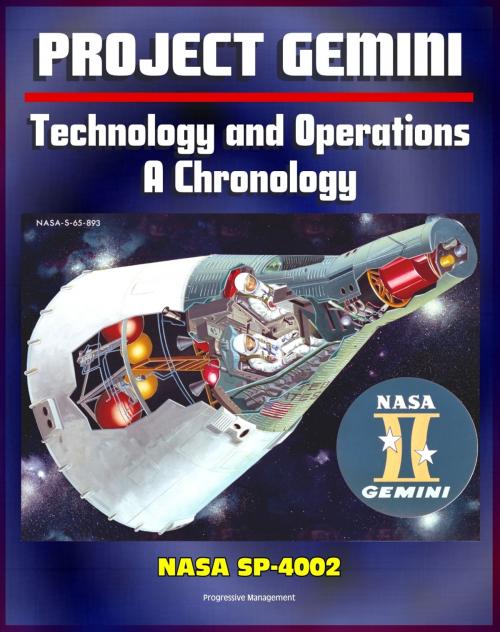Project Gemini Technology and Operations: A Chronology - Comprehensive Official History of the Pioneering Two-Man Missions Paving the Way for the Apollo Moon Landings (NASA SP-4002)
Nonfiction, Science & Nature, Science, Physics, Astronomy, Other Sciences, History| Author: | Progressive Management | ISBN: | 9781466135024 |
| Publisher: | Progressive Management | Publication: | January 10, 2012 |
| Imprint: | Smashwords Edition | Language: | English |
| Author: | Progressive Management |
| ISBN: | 9781466135024 |
| Publisher: | Progressive Management |
| Publication: | January 10, 2012 |
| Imprint: | Smashwords Edition |
| Language: | English |
This official NASA history document - converted for accurate flowing-text e-book format reproduction - is a comprehensive account of the events of Project Gemini, which paved the way for the successful Apollo moon landing program.
From the Introduction: "Project Gemini was the United States' second manned space flight program, a bridge between the pioneering achievement of Project Mercury and the yet-to-be realized lunar mission of Project Apollo. This Chronology, a step in preparing the history of Project Gemini, marks the completion of the first phase of our study of the Gemini program and lays the foundation for the narrative history that will follow. What we have done must stand as an independent work in its own right. But at the same time, some of its characteristics- in particular, what it contains and what it omits- can be properly justified only in terms of the larger whole of which it is a part. We have deliberately focused this Chronology very narrowly, excluding much material of undoubted relevance to the background of events, the context of decision, and to other matters that might be characterized as the external environment of Project Gemini. In part this is the inevitable result of a chronological format, which leaves little scope for explaining and interpreting events. Equally important, however, was our decision to reserve for the less restricted confines of a subsequent narrative history our confrontation with the subtle problems of interpretation and causation, of controversy and cooperation, of individual achievements and failures in the Gemini program. Several major features of this text grew directly from this decision.
Our orientation throughout has been primarily institutional. Organizations rather than individuals are ordinarily the actors in events as we describe them. The point of view embodied in most of the entries is that of Gemini Program Office (the Manned Spacecraft Center element created to carry through the Gemini program) and of major Gemini contractors. The events that we have been most concerned to elucidate are technological - the engineering and developmental work which transformed the concepts and objectives of the Gemini program from idea to reality. This Chronology is fully documented, with sources for each entry in the text cited immediately after the entry. Our greatest, though not exclusive, reliance has been on primary sources. Of these, perhaps the most widely useful have been the various recurring reports issued by both NASA and contractor organizations. Foremost among these are the Project Gemini Quarterly Status Reports, the Manned Spacecraft Center weekly and monthly activity reports and contractor monthly progress reports. Another extremely useful class of materials comprises nonrecurring reports and documents, such as working papers, technical reports, statements of work, mission reports and analyses, familiarization manuals, and final reports. The third major body of sources consists of the records of various NASA organizations, particularly Gemini Program Office records. These include notes, minutes and abstracts of meetings, official correspondence, telegrams, memorandums, reading files, and the like."
The most significant achievements of Gemini involved precision maneuvering in orbit and a major extension of the duration of manned space flights. These included the first rendezvous in orbit of one spacecraft with another and the docking of two spacecraft together. The docking operation allowed the use of a large propulsion system to carry men to greater heights above Earth than had been previously possible, thereby enabling the astronauts to view and photograph Earth over extensive areas.
This official NASA history document - converted for accurate flowing-text e-book format reproduction - is a comprehensive account of the events of Project Gemini, which paved the way for the successful Apollo moon landing program.
From the Introduction: "Project Gemini was the United States' second manned space flight program, a bridge between the pioneering achievement of Project Mercury and the yet-to-be realized lunar mission of Project Apollo. This Chronology, a step in preparing the history of Project Gemini, marks the completion of the first phase of our study of the Gemini program and lays the foundation for the narrative history that will follow. What we have done must stand as an independent work in its own right. But at the same time, some of its characteristics- in particular, what it contains and what it omits- can be properly justified only in terms of the larger whole of which it is a part. We have deliberately focused this Chronology very narrowly, excluding much material of undoubted relevance to the background of events, the context of decision, and to other matters that might be characterized as the external environment of Project Gemini. In part this is the inevitable result of a chronological format, which leaves little scope for explaining and interpreting events. Equally important, however, was our decision to reserve for the less restricted confines of a subsequent narrative history our confrontation with the subtle problems of interpretation and causation, of controversy and cooperation, of individual achievements and failures in the Gemini program. Several major features of this text grew directly from this decision.
Our orientation throughout has been primarily institutional. Organizations rather than individuals are ordinarily the actors in events as we describe them. The point of view embodied in most of the entries is that of Gemini Program Office (the Manned Spacecraft Center element created to carry through the Gemini program) and of major Gemini contractors. The events that we have been most concerned to elucidate are technological - the engineering and developmental work which transformed the concepts and objectives of the Gemini program from idea to reality. This Chronology is fully documented, with sources for each entry in the text cited immediately after the entry. Our greatest, though not exclusive, reliance has been on primary sources. Of these, perhaps the most widely useful have been the various recurring reports issued by both NASA and contractor organizations. Foremost among these are the Project Gemini Quarterly Status Reports, the Manned Spacecraft Center weekly and monthly activity reports and contractor monthly progress reports. Another extremely useful class of materials comprises nonrecurring reports and documents, such as working papers, technical reports, statements of work, mission reports and analyses, familiarization manuals, and final reports. The third major body of sources consists of the records of various NASA organizations, particularly Gemini Program Office records. These include notes, minutes and abstracts of meetings, official correspondence, telegrams, memorandums, reading files, and the like."
The most significant achievements of Gemini involved precision maneuvering in orbit and a major extension of the duration of manned space flights. These included the first rendezvous in orbit of one spacecraft with another and the docking of two spacecraft together. The docking operation allowed the use of a large propulsion system to carry men to greater heights above Earth than had been previously possible, thereby enabling the astronauts to view and photograph Earth over extensive areas.















